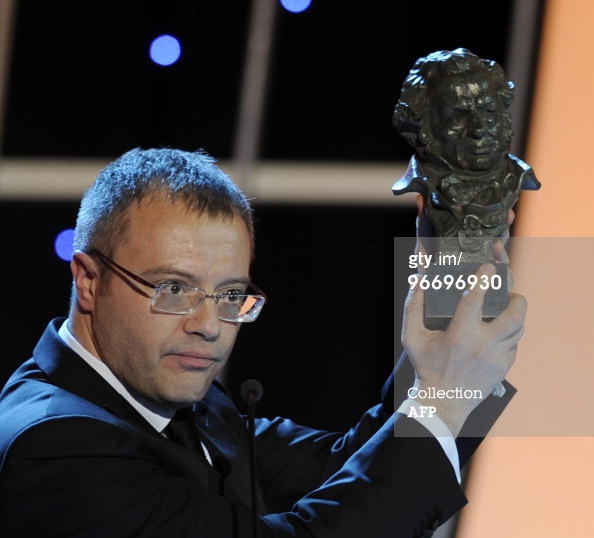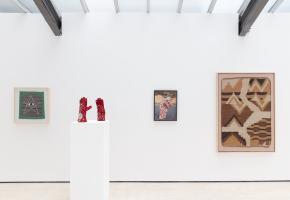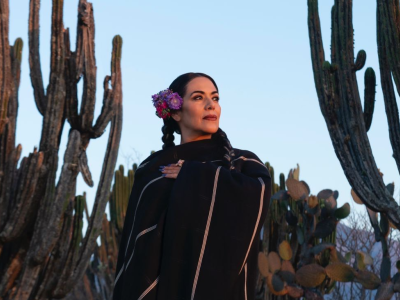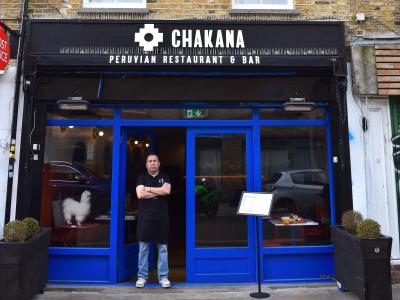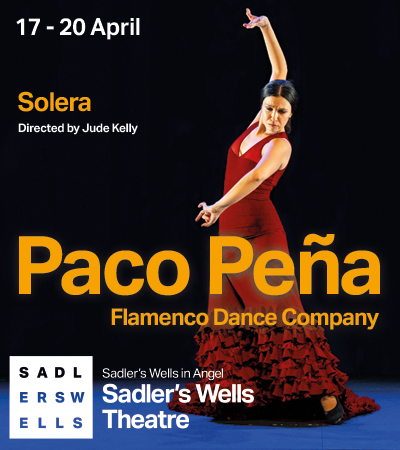Born in Majorca and working as a journalist and film critic, then in television, before getting into film through scriptwriting, Monzon's first feature-length films won prizes at international film festivals. His 2006 thriller Celda 211 (Cell 211) featured Luis Tosar, undoubtedly one of the greatest and prolific actors in Spain today. It won eight Goya prizes including Best Film and Best Director. His latest film, El Niño explores the issue of drugs trafficking between Spain and Morocco, specifically in the Strait of Gibralter. Motivated by the prestige, as well as the economic crisis, “El Niño” (Jesus Castro) is persuaded by his friend to traffic hashish in a speedboat by night, tearing across the ocean from Africa to Europe. On the other side of the law, Jesus (Luis Tosar) is a haggard cop who has spent years trying to trace a large-scale trafficker in the area known only as “El Inglés”. In his second interview with LatinoLife, Monzón explains the genesis and creation of his latest high-octane, visually stunning thriller.LatinoLife: Celda 211 is a very claustrophobic, psychological thriller. Did you want to go to the other extreme with El Niño, which is all about adrenaline, helicopters and the open sea?Daniel Monzón: Celda 211 is definitely claustrophobic; everything happens in one enclosed space. So visually, El Niño certainly is the exact opposite, considering that it largely takes place at sea. Also the story is about journeys and movement; we filmed in Morocco, Gibraltar and the south of Spain and the shots are mainly exteriors, with lots of sky. But the two films do share some similarities with each other, in the sense that they are both stories completely based on reality. For Celda 211, even though Jorge Guerricaechevarría (the scriptwriter) and I wrote the script based on a novel, we went to prisons to talk to prisoners and prison workers to make the film more visceral, more real and human. We realised it was the best way to lend the film that authenticity. For El Niño, we went to the Strait of Gibraltar and Morocco and we talked to the people who in reality live the lives of the film’s protagonists, both the police and the criminals. The whole story came from what they told us. So in that way, the two films are similar because they were inspired in a similar way. They both try to tell a story in a film noir kind of way, based on what really happens and what we were told by the real-life protagonists. We spent eight months in the Strait of Gibraltar, and everything in the final product was something that we experienced first-hand or were told about there. But it is true that on an aesthetic level, they look diametrically opposed.LatinoLife: So where did the idea for the film come from, before you went to the Strait of Gibraltar?Daniel Monzón: Well, I was born on Mallorca and I’ve always been drawn to the sea. I’ve always wanted one of my films to have the sea as its protagonist. So one day my scriptwriter talked to me about how due to the crisis in Spain, the young men who smuggle hashish from Morocco to the south of Spain in speedboats were taking to the waters of the Strait of Gibraltar in bigger numbers than ever before. He said that it had the potential for a great film, and that he could visualise these young men in fast boats, adrenaline coming out of their pores, with the open sea as a backdrop. So straight away I began to look online for more information and I found videos that the police had uploaded on YouTube of them in their helicopters going after these speedboats. It took no time to realise that visually the film could be stunning, and that this was the film in which the sea could be a leitmotif, just as I had wanted to do. I
In addition, Jorge and I realised that the issue of drugs smuggling in the Strait of Gibraltar was something that we read everyday in the newspaper, and which we saw on television on the news, but a film had never been made about it. Incredibly, it was virgin territory in terms of cinema. It was almost begging us to come and tell its story. So we went to the region for eight months, collecting information about the issue from both sides of the law, from everyone involved.
The Strait of Gibraltar has so many borders, so many contrasts and conflicts. You have huge luxurious houses where the smugglers live, dressed in Armani, whereas opposite there are terribly poor neighbourhoods, whose residents also work in smuggling but are lower in the pecking order. You have this confrontation between two continents, Africa and Europe. And then, of course, you have three countries in an area which is just fourteen kilometres squared - Spain, Morocco and the United Kingdom. It’s a region with so many nationalities, so many countries, and both the Atlantic and the Mediterranean sea. It’s also incredibly beautiful. You can just see the mountains of Africa from the southernmost point of Spain. It was logical that one day a film would be set there in the midst of that convergence of worlds, and we were lucky enough to be the first ones to do it.Edmon Roch: It’s not only a gripping story, it’s also completely true. I was aware of some of the facts about drugs smuggling in that region, but there was also a lot I didn’t know. What Daniel saw when he went there lent itself to a film which is visually appealing but with a dramatic and very human storyline. You can really tell that Jorge and Daniel spent eight months investigating there, it’s reflected in the final product. Plus the great success of Celda 211 opened a lot of doors for them, because people knew that Daniel is a great storyteller who always takes into consideration both sides of the story, in an honest way. As a result, they were able to talk to the Guardia Civil, the police, the customs authorities, as well as the criminals, the people who traffic around there. Slowly they began to assemble all these bits of truth into one story, one true story which breathes a million smaller stories, with the advantage that it allows the viewer to enjoy the adrenaline, the journey, and the drama of it all. Daniel Monzón: It was interesting because when we talked with the young kids who traffic with speedboats, we realised that it was going to be a very different film compared with the ones about drugs smuggling around the Mexico-U.S. border. The characters are different in those; they’re violent, exaggerated, larger than life, whereas these kids from the south of Spain almost do what they do without realising the gravity of it. They treat it as if it were a video game, despite it being very dangerous. So for that reason the film has a lot more tenderness. It’s a film that doesn’t judge any of the characters, not even the corrupt ones. That region is full of temptation, it’s so easy to make huge amounts of money from smuggling. You need serious restraint, and moral fibre, to be able to resist that temptation, whether you are a kid with a speedboat or an officer of the law. Even more so with the crisis which is devastating Spain, and that doing something that involves so much money and risk-taking leads to prestige and admiration from the people around you. Your life becomes an adventure. This is what we saw, and this is the idea we tried to get across with El Niño, which is clearly very Spanish, very idiosyncratic and different from any other narco film that you see come out of North America.
[[{"type":"media","view_mode":"media_large","fid":"3737","attributes":{"alt":"","class":"media-image","height":"200","typeof":"foaf:Image","width":"450"}}]]LatinoLife: So how has the crisis affected not only the situation in the Strait of Gibraltar but also the making of El Niño?Daniel Monzón: The crisis has not only affected the people of Spain but also has resulted in the proliferation of the drugs trade in the Strait of Gibraltar. It is something that has been happening for hundreds of years. It started with penicillin, then it was tobacco, then it was hashish and alcohol, and later cocaine. The Strait of Gibraltar is the gateway to Europe, everything passes through there, from Africa and from Latin America. The cocaine that something is sniffing in central Europe passes through there, as does the material to make haut-couture clothing in Paris. So the crisis of course has affected the phenomenon which El Niño is about, but it also gravely affected the making of the film. We were offered a much bigger budget by an American production company to film it in English. Edmon Roch: The budgets that you get offered from that part of the world are mind-boggling. But Daniel quite rightly said that the film would have lost its idiosyncrasy if it had been filmed in English. Daniel Monzón: It didn’t make sense, it would have gone against everything the film is about. We said to them that the film had to be in Spanish, so we ended up with a very limited budget, especially considering the type of film that it is. Edmon and I spent one year going to locations, companies, to explain the project and trying to create interest about it. It was a lot of work, to be able to make the film happen.Edmon Roch: We always said, when money was short we had to compensate with time. It’s one thing or the other. If you have a large budget, you can spend less time making a film. If you don’t you spend a lot of time convincing people it’s worth their investment. Having said that, within Europe we had a lot of support, thanks once again to Celda 211 and Daniel’s work. There were a lot of people who wanted to be part of his latest project. It was obvious that El Niño was worth investment from the start, StudioCanal were interested in the commercial side of it and this helped us piece everything together. Daniel Monzón: In fact, at one point the film came to a halt for a whole year, because of the crisis. But we didn’t waste that year. I was rehearsing with the cast members who had never acted before, because most of the characters are played by people with no acting experience whatsoever. I wanted that freshness, that authenticity to permeate the film. LatinoLife: How was the collaboration between the actors who had never acted before, and the well-established actors who also appear in the film, such as Luis Tosar?Daniel Monzón: That really was the biggest challenge of the film for me, as the collaboration between actors is completely the responsibility of the director. I knew from the beginning that the eponymous character, El Niño himself, had to come from that part of Spain, as well as the other youngsters. So we did long, complex castings and we saw thousands of young kids from the area. When we found Jesús Castro and the rest of the cast, I kept them and the professional actors separate. With the professionals, I observed how police operate, we’d fly in helicopters, and then I would work with the youngsters on their roles on an individual basis. They were kept in two separate worlds like you see in the film, which is how it is in real life.
The young traffickers like to pretend that the police don’t exist. So it continued like that for a while, trying to adapt the personalities of the scripted characters to the new actors’ actual personalities. Jesús Castro wasn’t becoming El Niño - it was El Niño becoming Jesús Castro. Also, even though he doesn’t drive a car, it was Jesús himself doing all his own stunts in the speedboat so we spent some time practicing that. We also rented an apartment so that all the kids got to know each other, in order to make sure that their friendship really came across on-screen. And it worked incredibly well keeping them apart, so that the kids weren’t afraid of the professional actors, like Luis Tosar, and the professionals didn’t worry about anything except the development of their characters.
It was only a few days before we began filming that the new actors and the professionals met each other. We went through the script together, all together in one room. It was incredible: the professionals were confronted with the new actors, who were the real deal, born and bred in the region, and wondered how they could possibly compete with these authentic individuals from southern Spain; it made them realise just how naturalist the film was going to be. Meanwhile the kids had these embodiments of the police, these perfect imitations, standing in front of them. When we left that reading, Luis Tosar said it was one of the most intense moments of his acting career. Keeping the actors apart and finally bringing them together charged the filming process with such energy.
[[{"type":"media","view_mode":"media_large","fid":"3738","attributes":{"alt":"","class":"media-image","height":"359","typeof":"foaf:Image","width":"540"}}]]LatinoLife: What was the most fun scene to film?Daniel Monzón: Every minute was fun. I probably would say that the most fun thing to film was the stunt with the helicopter and the speedboat. We spent two weeks filming at sea, being hit with waves, water in the eyes and ears, with the helicopter flying above our heads. It was amazing. Amazing, but difficult. We would arrive back at the hotel completely destroyed, but also with the satisfaction that we had got some incredible footage. When we got to Cannes Film Festival, everyone was amazed by the barbarity of that sequence. And that was because it had basically really happened during the filming.LatinoLife: And lastly, what plans do you have for the future? Are you both off to Hollywood for those mind-boggling budgets?Edmon Roch: I’m certainly not. I have worked in Hollywood with big budgets, but what that entails is a complete loss of creative freedom, so I returned to Spain so I could do what I wanted and have control over it, like with films as interesting as El Niño. For me, that’s a greater privilege than earning lots of money.Daniel Monzón: I completely agree with Edmon. They have offered me blockbusters but what I like is that the final product is something which I have personally envisioned. Where’s the sense in not making something which is not mine? I would have no problem filming in English or in England or the United States, but the budget is irrelevant because you always adapt as a director to whatever the budget is. What matters most is having complete creative control.


